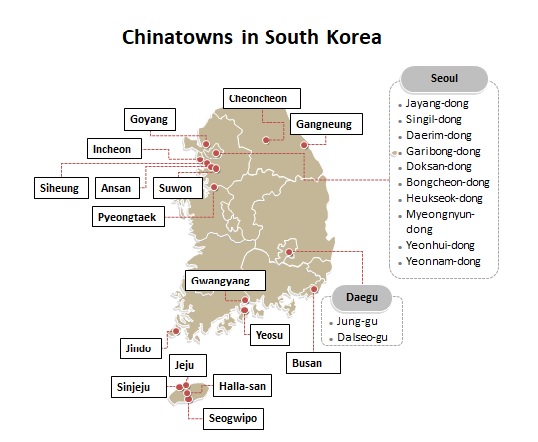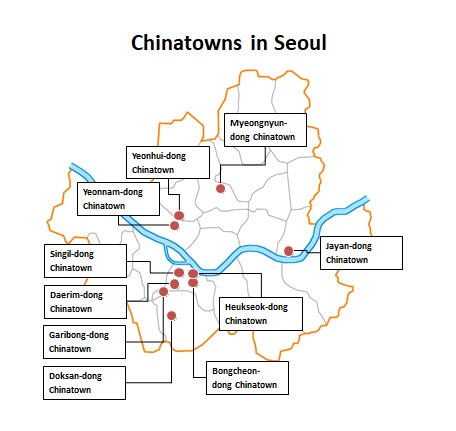Why the U.S. Can't Get Israel to Break Up With China
________
Source: East Asia Research Center
Almost Secret: China's Extensive Belt and Road Initiative, Nearly 30 Chinatowns in South Korea
June 10, 2020 | By Tara O
When discussing China's Belt and Road Initiative, often, nothing is shown on the map for South Korea in major press reporting; however, China's Belt and Road Initiative projects are active and wide-spread in South Korea. South Korea developed extensive infrastructure decades before China, thus China is not building roads and bridges in an infrastructure-poor country. Instead, China is building enclaves, some of them massive, in South Korea.
A massive Chinatown is being built in a large area in Chuncheon City and Hongcheon County in Gangwon Province (east of Seoul), South Korea, as part of China's Belt and Road Initiative. (0:06) The land area of this "China Cultural Complex Town" is 1,200,000 square meters (=129,166,923 square ft = 297 acres = 168 soccer fields), which is inside the La Vie Belle Tourism Zone (라비에벨관광단지). (0:07) It is 10 times larger than the Chinatown in Incheon, where the oldest Chinatown (and also the only one in South Korea for decades until recently) is located; it has expanded greatly in the last decade or so. (0:15)
Massive "China Cultural Complex Town" in Chuncheon City and Hongcheon County, South Korea, part of China's Belt and Road Initiative
According to the Gangwon Provincial office, Governor Choi Moon-soon (최문순) went to Beijing to attend the launching ceremony of the Chinese Cultural Complex Town creation project, and on December 6, 2018, signed an agreement with the People's Network (人民網), Kolon Global Co. [코오롱글로벌(주)], Internal and External Residents Co. [㈜내외주건], and Korea Wushu Association to build a Chinese Cultural Complex Town in Gangwon Province. The People’s Network is a subsidiary of the Chinese Communist Party's (CCP) mouth piece, People's Daily.
The estimated project cost is ₩600,000,000,000 (~$540 million), and the Internal and External Residents Company is to raise funds, and Chinese capital will likely play a key role. (0:43) This is in line with China's Belt and Road deals, which involve China lending vast amounts of money to other countries for ventures and infrastructure projects. The People's Daily and People's Network will be in charge of developing the project planning, "cultural content," finding Chinese investors, promotion, and advertising of the cultural complex project. (1:26)
Gangwon Province Governor Choi Moon-soon visiting China
Governor Choi Moon-soon is in the ruling party, the Deobureo Minjoo Party (Democratic Party of Korea), which has signed an MOU with the CCP. Choi has stated he is "glad to attend the meaningful ceremony officially announcing the "China Cultural Complex Town," China’s only "One Belt One Road" project in South Korea" [it turns out there are more] and described the Chinatown as "a little China in Gangwon Province, the Republic of Korea." (0:51) Although the South Korean government has not officially stated it is participating in the "One Belt One Road" project, the Chinese official website on One Belt One Road stated it as such as well. (2:47) Choi will provide licensing, visas, and other administrative support for the project. The governor’s office expects increased tourism.
National security experts, however, are expressing strategic and security concerns. Less than 10 minutes away are numerous military installations, including one for the 11th Division (Reserves). (1:01) Professor Park Hui-rak stated there are reserve forces in Hongcheon, and these reserve forces are even more important than the active duty in some ways, and he expressed concern that a country that views South Korea as a vassal state is so near the military facilities and forces important to South Korea's national security. (1:15) Nearby is also one of the key combined training ranges for the South Korean and U.S. militaries. Many local residents were not aware that such a huge Chinatown is being built in the region. (1:38)
In addition to the "China Cultural Complex Town," a 15-story luxury hotel for Chinese tourists is also under construction in Jungdo (Middle Island), a different part of Chuncheon City. This is at a historical site where they discovered over 10,000 historical artifacts, making it one of the world's largest prehistoric artifact sites. (1:55) Gangwon Province pressed ahead with the construction, despite the opposition of the civil society organizations for preserving artifacts and the site.
Please go to East Asia Research Center to read the entire article.


No comments:
Post a Comment
Note: Only a member of this blog may post a comment.